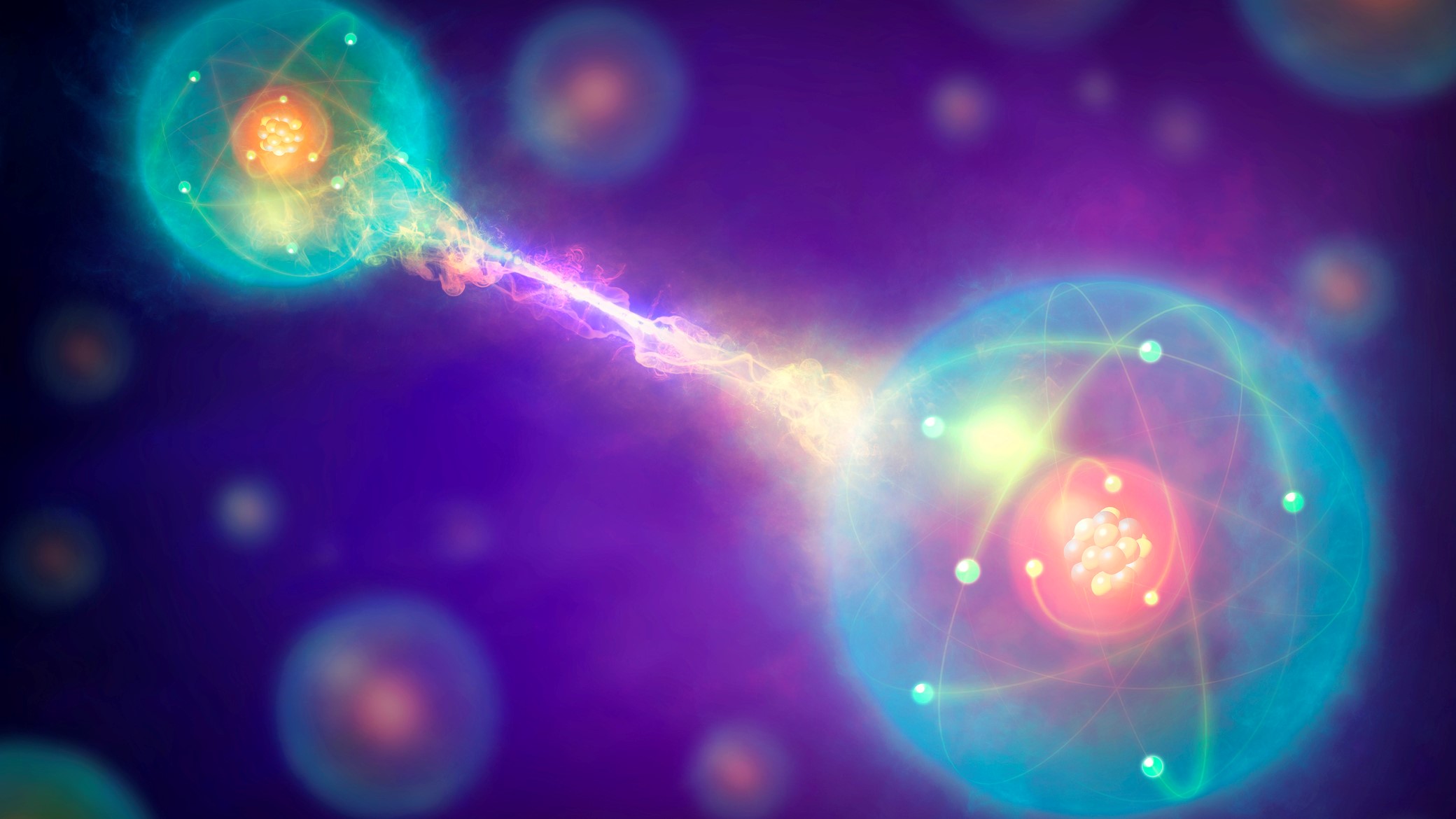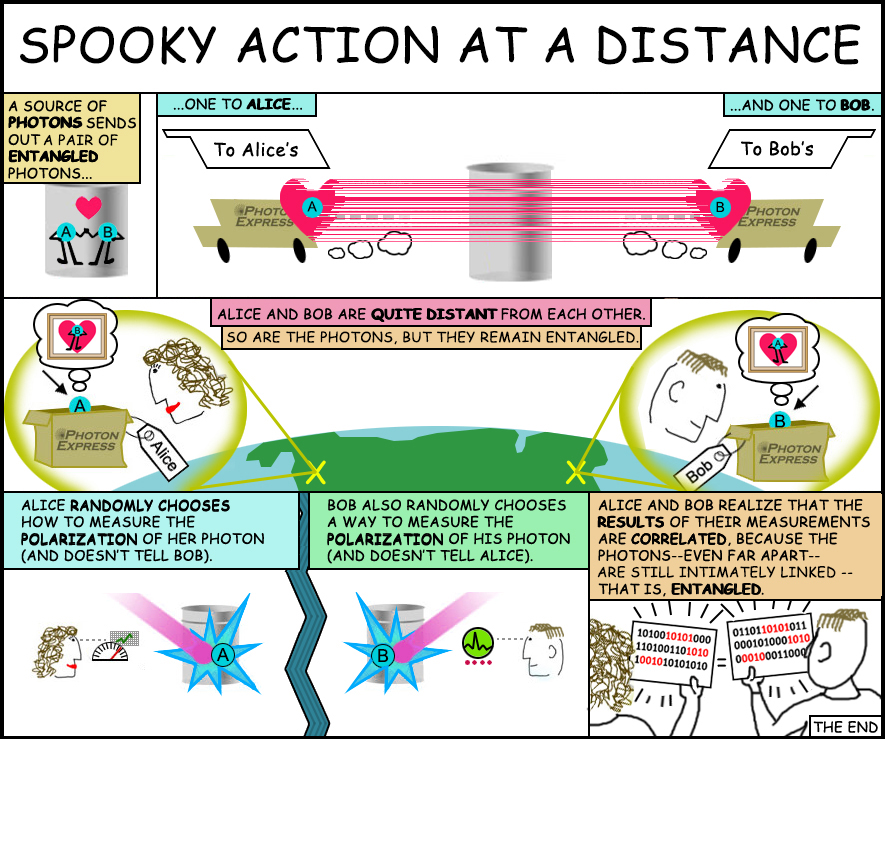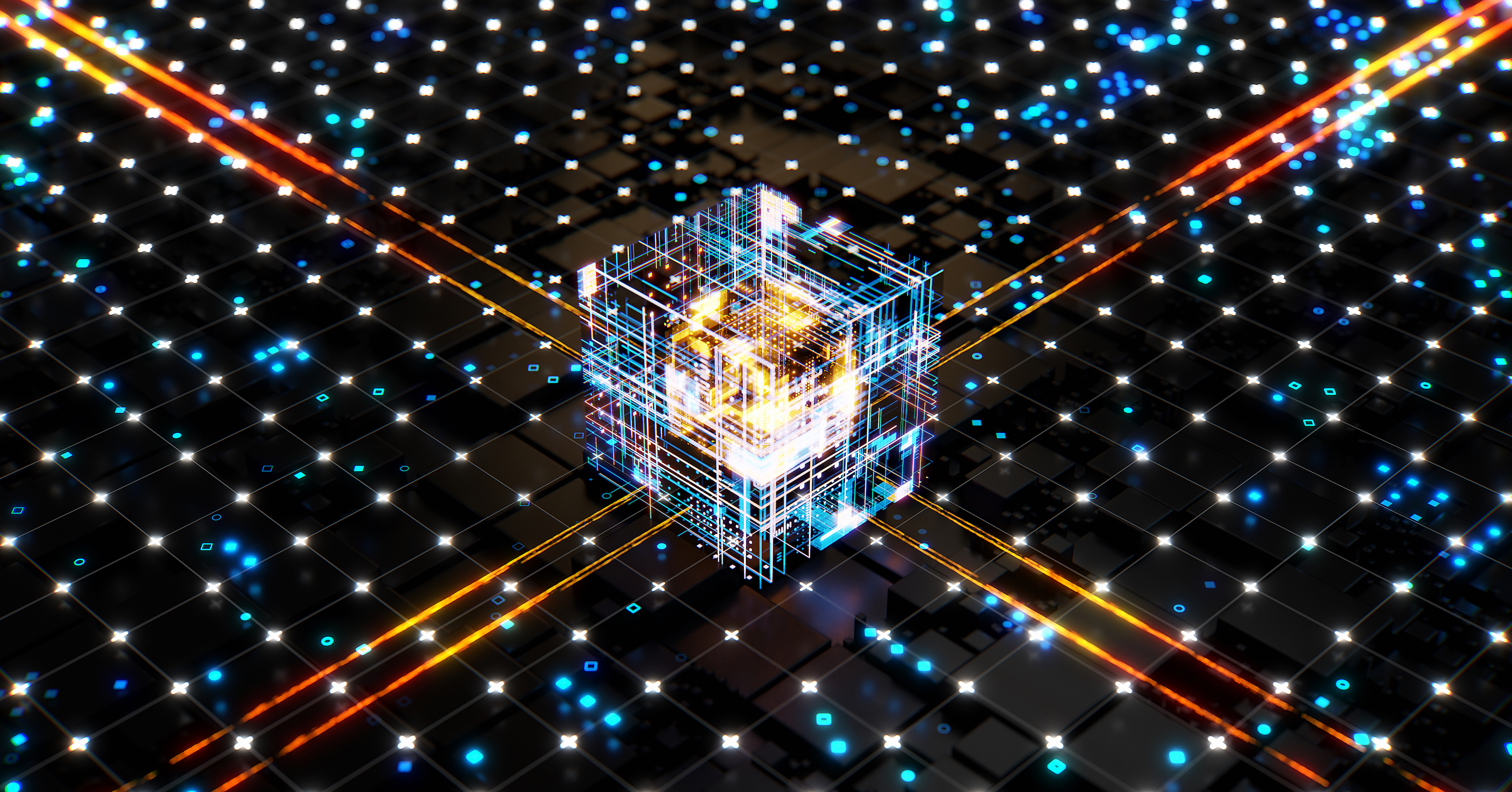
Quantum entanglement is a fascinating, counterintuitive phenomenon where two subatomic particles remain deeply connected, even if separated by billions of light-years. A change in one particle instantly influences the other, regardless of the distance between them.
In 1964, physicist John Bell posited that such changes can be induced and occur instantaneously, even if the particles are very far apart. Known as Bell's Theorem, this groundbreaking idea challenged established physics principles.
Decades earlier, Albert Einstein had demonstrated that no information could travel faster than the speed of light. Troubled by this contradiction, Einstein memorably referred to entanglement as "spooky action at a distance."
Quantum entanglement FAQs answered by an expert
We asked Alan Migdall a fellow at the Joint Quantum Institute at the University of Maryland and leader of the Quantum Optics Group at the National Institute of Standards and Technology, a few frequently asked questions about quantum entanglement.
What is quantum entanglement?
Quantum entanglement is when a system is in a "superposition" of more than one state. But what do those words mean? The usual example would be a flipped coin. You flip a coin but don't look at the result. You know it is either heads or tails. You just don't know which it is. Superposition means that it is not just unknown to you, its state of heads or tails does not even exist until you look at it (make a measurement). If that bothers you, you are in good company. If it doesn't bother you, then I haven't explained it clearly enough.
You might have noticed that I explained superposition more than entanglement. The reason for that is you need superposition to understand entanglement. Entanglement is a special kind of superposition that involves two separated locations in space. The coin example is superposition of two results in one place. As a simple example of entanglement (superposition of two separate places), it could be a photon encountering a 50-50 splitter. After the splitter, the photon could be In path A, or it could be in path B. In this case, the superposition is between
a photon in path A and no photon in path B.
and
no photon in path A and a photon in path B.
As a normal human being, you think that it is in just one or the other, and it is just that you don't know which. But in fact, it is in both, until you actually measure it. Again, that normal human being wants to say that if I measured it and found it in path A, it was in path A even if I hadn't measured it. But making that assumption gets you into trouble. Assuming the particle has that definite characteristic before you actually measured it, leads to measured results that are just not possible.
How does quantum entanglement work?
What is an example of quantum entanglement?
An example of quantum entanglement that I work with involves a light source that emits two photons at a time. Those two photons of a pair can be entangled so that the polarizations of the individual photons can be any orientation (i.e., random), but photons of a pair always have matching polarizations.
What is polarization? The polarization of light depends on the electric field of the light wave. As the light travels from point one point to another, its electric field will oscillate transversely to that propagation direction. It might oscillate in the vertical plane, in the horizontal plane or any direction in between.
Back to those entangled pairs. So, if I measure the polarization of photon A to see if it is polarized horizontal or vertical, I get an answer and find it to be, this time, vertical. Entanglement means that when I measure whether its twin is horizontal or vertical, I find that its polarization is vertical too. If I do that experiment many times, I will always find that the two photons' polarizations match, even if I find that the result of which polarization they match to is random. (Think a pair of magical loaded dice.) So, a key point is that the measurement result will be random, but if I make the same measurement on the twin, I will get that same random result. (Again, as a normal human being, that should bother you.)
Is quantum entanglement faster than the speed of light?
Asking about speed is a very interesting question. You might as a "normal human being" think that if I measure the polarization of one photon, that sets the state of the other photon. That thinking is fine, as long as the other photon measurement happens after the first measurement. But there is already a problem. If that second photon is measured on Pluto, it might take 6 hours for light to get there, so because information cannot travel faster than the speed of light, the second photon wouldn't know what state it should be. But it turns out that that second measurement will always match the first no matter when it was measured. So, it seems like the necessary information must have traveled faster than the speed of light. Big problem, but entanglement's weirdness gets it out of an astronomical speeding ticket.
In the case of entanglement, the information that appears at your Pluto measurement station is not useful information (in the ordinary sense). It is random just like the random result that came out of that first measurement (but matching random). So, the key point is that you could not take advantage of news of a crop failure and send a buy or sell order to your stockbroker on Pluto at faster than the speed of light before the Plutonian markets had time to adjust. It is only "randomness" that appears to travel faster than light, so the galactic traffic cop just lets you off with a warning.
The inherent randomness of quantum mechanics and entanglement is a useful resource. It allows you to address two issues. It guarantees randomness and it can be arranged to guarantee it is fresh randomness. Both of those are important. For example, in a lottery, we all know that the numbers should be random, but if they existed for a long time, someone could have made a copy of them and then they would know what number is coming next.
If you have a way of guaranteeing that the randomness was generated very recently, you minimize the time someone has to hack your system and secretly copy those numbers. And then there is the use of entanglement for quantum computing, but I'll leave that for someone else.
Have we proven quantum entanglement?
For more than 50 years, scientists worldwide experimented with Bell's Theorem but were never able to test the theory fully. In 2015, however, three different research groups were able to perform substantive tests of Bell's Theorem, and all of them found support for the basic idea.

One of those studies was led by Krister Shalm, a physicist with the National Institute of Standards and Technology (NIST) in Boulder, Colorado. Shalm and his colleagues used special metal strips cooled to cryogenic temperatures, which makes them superconducting, meaning they have no electrical resistance. A photon hits the metal and turns it back into a normal electrical conductor for a split second, and scientists can see that happen. This technique allowed the researchers to see how if at all, their measurements of one photon affected the other photon in an entangled pair.
Related: 10 mind-boggling things you should know about quantum entanglement
The results, which were published in the journal Physical Review Letters, strongly backed Bell's Theorem. "Our paper and the other two published last year show that Bell was right: any model of the world that contains hidden variables must also allow for entangled particles to influence one another at a distance," co-author Francesco Marsili, of NASA's Jet Propulsion Laboratory (JPL) in Pasadena, California, said in a statement.
What is quantum entanglement used for?
In addition to proving Bell's Theorem, there are practical applications to this work as well. The "superconducting nanowire single-photon detectors'' (SNSPDs) used in that experiment, could be used in cryptography and in deep-space communications, NASA officials said.
NASA's Lunar Atmosphere Dust and Environment Explorer (LADEE) mission, which orbited the moon from October 2013 to April 2014, helped demonstrate some of this communications potential. LADEE's Lunar Laser Communication Demonstration used components on the spacecraft and a ground-based receiver similar to SNSPDs. The experiment showed that it might be possible to build sensitive laser communications arrays that would enable much more data to be up and downloaded to faraway space probes, NASA officials said.

Additional resources
For a more in-depth definition and exploration of quantum entanglement, check out Jed Brody's "Quantum Entanglement (The MIT Press Essential Knowledge series)" (Knopf, 2008). Read the fascinating stories about what life was like at the time of quantum entanglement's discovery in Louisa Gilder's "The Age of Entanglement: When Quantum Physics Was Reborn" (Deckle Edge, 2008). Or, take a broader look at quantum physics as a whole in this book, "Quantum Physics for Beginners: From Wave Theory to Quantum Computing. Understanding How Everything Works by a Simplified Explanation of Quantum Physics and Mechanics Principles" by Carl J. Pratt (Independently published, 2021).
Bibliography
- EmLandau, 2016. "Particles in Love: Quantum Mechanics Explored in New Study." NASA Jet Propulsion Laboratory. https://www.nasa.gov/feature/jpl/particles-in-love-quantum-mechanics-explored-in-new-study
- Myrvold et al., 2019. Bell's Theorem. Stanford Encyclopedia of Philosophy. https://plato.stanford.edu/entries/bell-theorem/#EarlExpeTestBellIneq
- O'Neil, 2022. "Space Station to Host 'Self-Healing' Quantum Communications Tech Demo." NASA Jet Propulsion Laboratory, California Institute of Technology. https://www.jpl.nasa.gov/news/space-station-to-host-self-healing-quantum-communications-tech-demo







